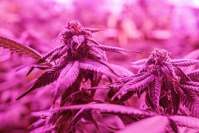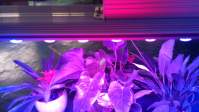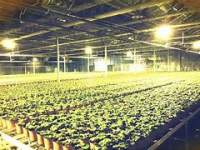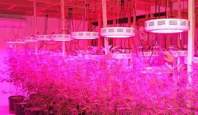The effect of LED plant lights on plant growth
The wavelength of LED plant lights is very suitable for the growth, flowering and fruiting of plants. Generally, indoor plants and flowers will grow worse and worse with the change of time. The main reason is the lack of light irradiation. The LED plant light can not only promote its growth, but also prolong the flowering period and improve the quality of the flowers. The application of this high-efficiency light source system to agricultural production in greenhouses, greenhouses and other facilities, on the one hand, can solve the disadvantages of insufficient sunlight leading to the decline in the taste of tomatoes, cucumbers and other greenhouse vegetables. On the other hand, it can also make winter solanum fruits in greenhouses. Vegetables will be put on the market before and after the Spring Festival in advance, so as to achieve the purpose of off-season cultivation.
Since the junction temperature can be determined by the average power consumption, even a large ripple current has little effect on the power consumption. In a buck converter, the peak-to-peak ripple current equal to the DC output current (Ipk-pk=Iout) will increase the total power loss by no more than 10%. If it is far more than the above loss level, then it is necessary to reduce the AC ripple current from the power supply in order to keep the junction temperature and operating life constant. A very useful rule of thumb is that for every 10 degrees Celsius decrease in the junction temperature, the semiconductor lifetime will be doubled. Due to the inhibitory effect of inductors, most designs tend to lower ripple currents. The peak current in the LED plant light should not exceed the maximum safe working current rating specified by the manufacturer.
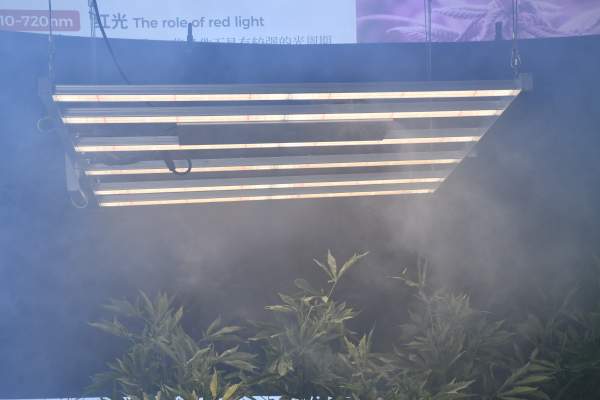
When it is lower than the turn-on threshold of the LED plant lamp (the turn-on voltage threshold of the white light LED is about 3.5V), the current passing through the LED is very small. Above this threshold, the current will increase exponentially in the form of a forward voltage. This allows the LED plant light to be shaped as a voltage source with a series resistor, with a warning note: this model is only valid under a single working DC current. If the DC current in the LED plant light changes, then the resistance of the model should also change immediately to reflect the new operating current. Under a large forward current, the power dissipation in the LED plant light will cause the device to heat up, which will change the forward voltage drop and dynamic impedance. It is very important to fully consider the heat dissipation environment when determining the impedance of the LED plant light.
Adjustable brightness requires a constant current to drive the LED plant light, and the current must be kept constant regardless of the input voltage. This is more technically challenging than simply connecting an incandescent bulb to a battery to power it.
Why can LED plant lights promote plant growth? In the process of plant growth and development, light has two functions. One is an indirect function, which is the aforementioned photosynthesis, and another direct function is the formation of light forms. The wavelength types of LED plant production lamps are rich, which coincides with the spectral range of plant photosynthesis and light morphology.
The half-width of the spectrum wave width is narrow, which can be combined as required to obtain pure monochromatic light and compound spectrum, which can concentrate light of a specific wavelength to irradiate crops uniformly; not only can adjust the flowering and fruiting of crops, but also can control plant height and plant nutrition Ingredients: The system generates little heat and occupies a small space. It can be used in a multi-layer cultivation three-dimensional combination system to achieve low heat load and miniaturization of production space.
The external environment affects the growth and development of plants, of which light has the greatest impact. The characteristics of full-spectrum LED plant lights: rich in wavelength types, which coincide with the spectral range of plant photosynthesis and light morphology; the half-width of the spectral wave width is narrow, and pure monochromatic light and compound spectrum can be obtained by combining according to needs.
Why LED plant lights can promote plant growth
Plant growth light organic planting is a kind of production that does not use chemically synthesized fertilizers, pesticides, and growth regulators, nor does it use genetic engineering and ion radiation technology. Instead, it follows the laws of nature and adopts agricultural, physical and biological methods. Methods to fertilize the soil, prevent and control diseases and insect pests, to obtain a safe agricultural production system of organisms and their products.
The effects of light on plants (function: foil and setting off the main scenery) are mainly in two aspects: on the one hand, light is necessary for the photosynthesis of green plants; on the other hand, light regulates the entire growth and development of plants in order to better adapt to the outside world environment of. This reliance on light to control the differentiation, structure and function changes of cells will eventually inherit the formation of tissues and organs and become light morphogenesis.
In the case of insufficient sunlight, LED plant lights simulate the most favorable wavelength of sunlight for plant growth. There are two main spectral regions absorbed by plant chlorophyll, one is the red light part with a wavelength of 620~660nm, and the other is The wavelength is the blue part of 430~450nm. In addition, the absorption spectrum of lutein and carotene is the blue part of the wavelength of 400~500nm. Lutein and carotene absorb blue light and transfer energy to chlorophyll for photosynthesis. Therefore, the main spectral regions that can be utilized by photosynthesis are the red part with a wavelength of 620 to 660 nm and the blue part with a wavelength of 400 to 500 nm.
The above is all about why LED plant lights can promote plant growth. I hope to help everyone.


